#common orange lichen
Text
FOTD #043 : maritime sunburst lichen! (xanthoria parietina)
maritime sunburst lichen (AKA common orange lichen, yellow scale & shore lichen) is a foliose lichen in the family teloschistaceae. it has been found in north america, africa, asia, europe & australia !! it often grows in hardwood forests in broad, low-elevation valleys, or in populated areas.
the big question : can i bite it??
like most lichens, it is inedible, though it may have medicinal uses.



x. parietina description :
"the vegetative body of the lichen, the thallus, is foliose, & typically less than 8 centimetres (3.1 in) wide. the lobes of the thallus are 1–4 mm in diameter, & flattened down. the upper surface is some shade of yellow, orange, or greenish yellow, almost green when growing in shady situations, while the lower surface is white, with a cortex, & with sparse pale rhizines or hapters.
in xanthoria parietina, the thickness of the thalli is known to vary depending on the habitat in which it grows. the lichen pigment parietin gives this species a deep yellow or orange-red color."
[images : source, source & source]
[fungus description : source]
#• fungus of the day !! •#[xanthoria parietina]#: sunburst maritime lichen :#: yellow scale :#: shore lichen :#: common orange lichen :#043#||#fungi#fungus#mycology#earth#foraging#nature#cottagecore#forestcore#xanthoria parietina#lichen#lichenized fungi#sunburst maritime lichen#yellow scale#common orange lichen#shore lichen#fotd#fungus of the day
53 notes
·
View notes
Text
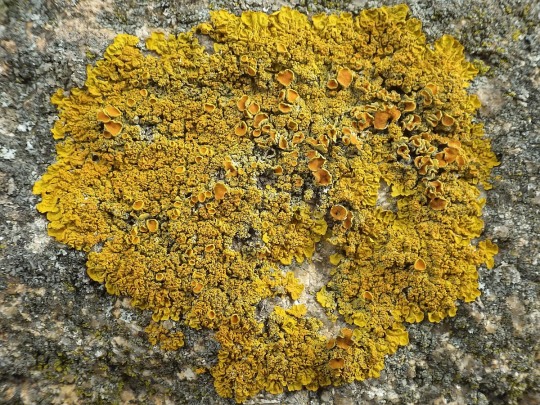

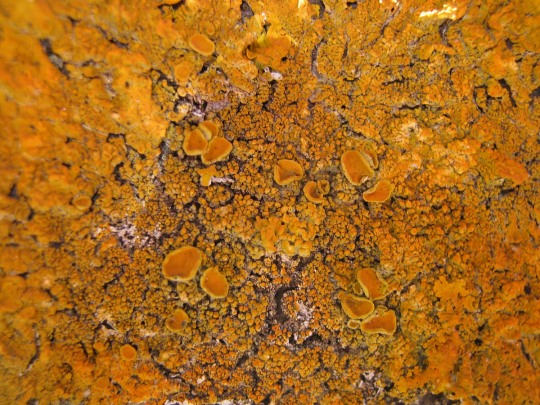
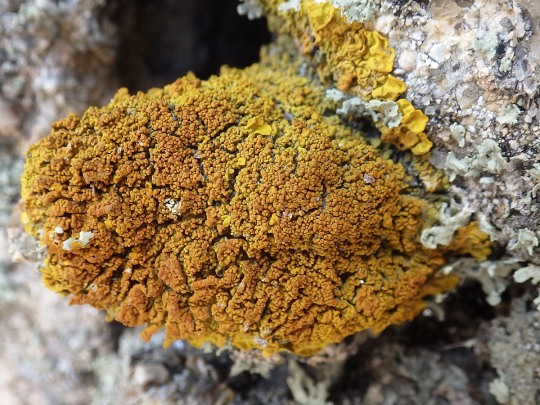

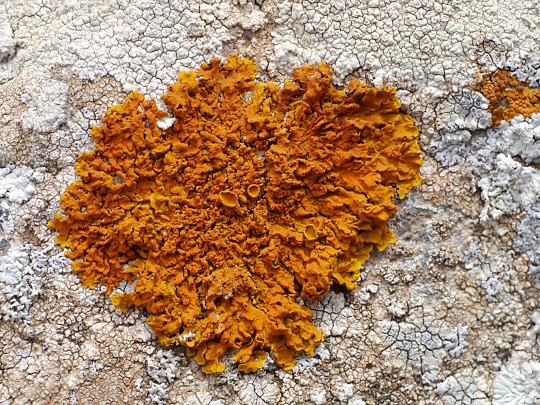



Xanthoria calcicola
This foliose lichen grows on calcareous rock and stone work (and occasionally dusty trees) in eutrophic, well-lit, mild-temperate and costal regions of Europe and the Mediterranean. It has a yellow-orange to dark orange foliose thallus forming pleated lobes growing in large rosettes up to 20 cm in diameter. The center of the rosettes are covered in knobbly warts and granular isidia, and it only rarely produces apothecia. The presence of these isidia and the lack of apothecia is the best way to distinguish this lichen from the very similar looking X. parietina which is a lot more common and often grows on bark.
images: source | source
info: source | source | source
#lichen#lichens#lichenology#lichenologist#mycology#ecology#biology#fungi#fungus#symbiosis#symbiotic organisms#algae#Xanthoria calcicola#Xanthoria#trypo#trypophobia#life science#environmental science#natural science#nature#the natural world#beautiful nature#weird nature#naturalist#I'm lichen it#lichen a day#daily lichen post#lichen subscribe#orange#orange lichen
258 notes
·
View notes
Text
Our Microbial Ecology professor is offering us extra credit if we can find three different kinds of lichen. My lab partners were unsure where to find lichens but the answer is simple, everywhere! The slightly more complicated answer is that they grow in the places that other plants and fungus can't grow, with rocks and tree bark being the most common. I was able to find all of these, in my own yard in about 10 minutes.
There was a colony like this one growing on the foundation of our house but I didn't want to disturb it so I was glad when I found this lovely specimen on a rock in our landscaping.

This was also on the same rock, it isn't a great picture but you can see the little rhizones that are used to attach themselves to the rock.
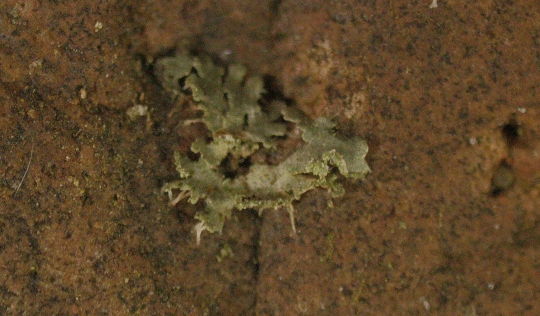
The reason lichens can grown on rocks and other inhospitable surfaces is because they are actually a symbiosis of two different organisms and there partnership is what makes it possible. Each lichen consists of mycobiont, a fungus, and a photobiont which is either an algae or a cyanobacteria. (a cyanobacteria is a kind of bacteria that can do photosynthesis.) The photobiont can produce energy through photosynthesis and the mycobiont can break down the substrate (yes, even rock) in order to get other nutrients that lichen needs to survive.
In fact here's another lichen I found on a rock in our landscaping. If you click on it to see the full sized image you can actually see the little grains of sand from the lichen breaking down the rock.
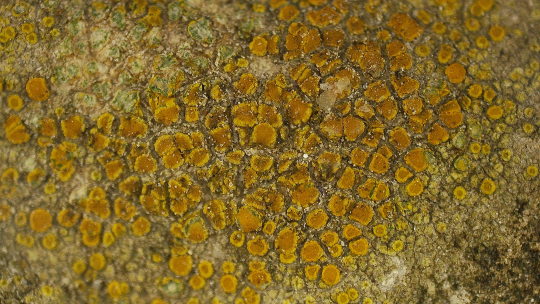
Keep in mind that this picture was taken at high magnification, to give you an idea of scale, here's the same lichen (or at least a very similar one) growing on a cement window sill at my kids school.

You can see how it might be overlooked as just some discoloration. If you've ever at an old cemetery, you'll see that a lot of the oldest headstones are pretty much completely yellow or orange, that's lichens.
This one was growing on a dead stick that had fallen off our apple tree. The round things are the apothecia, the reproductive structure of the fungal symbiont, that's why they often look like tiny mushrooms.

It can be very difficult to identify lichens to species because even lichens with different symbiotes can look very similar. If you were to disregard the apothecia, the one above looks a lot like the first lichen but the fact that they are on different substrates is evidence that they are different kinds. They aren't even the same growth form the first one is lobed and this one is foliose. I do own the keys to identify them, but I have yet to actually attempt to.
Lichen are also very particular about their habitat. The population on the apple tree (left) is very different from the population on the Cottonwood tree. (right)
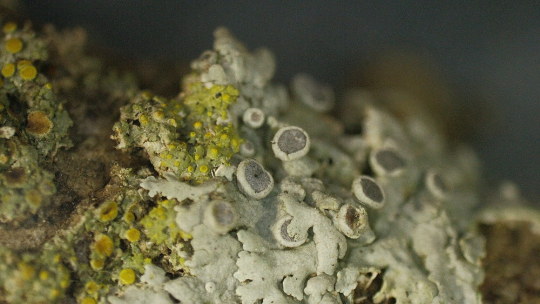

Disclaimer: all of these lichens are very common in this area and were either on loose rocks in our landscaping, bark that was already peeling off the tree or on dead branches. You should never collect lichens if you aren't confidant that they are well populated and it's best not to damage their substrate to collect them
Disclaimer 2: I am not a lichen expert by any means, the information here is correct to the best of my knowledge.
If you're interested, I have turned some of these pictures into desktop backgrounds, they can be found here:
44 notes
·
View notes
Text
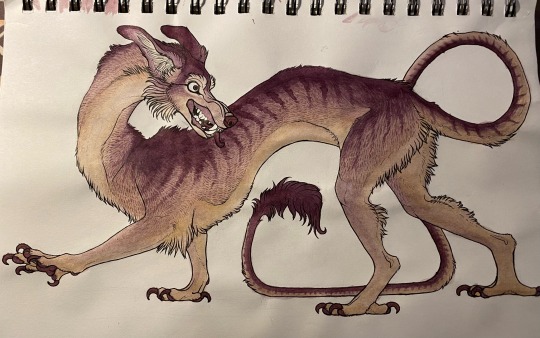
Watercolors made from ammonia fermented lichen that bears dye precursor acids, and boiled onion skins of differing pH. Pigma micron pen.
I imagine painting ammonia water directly onto the paper isnt ideal for archival quality, or the vinegar water either. But sometimes things are ephemeral and that's okay.
ammonia dyebath for the darkest purple, vinegar neutralized dyebath for a lighter purple, and then two shades of yellow/orange/tannish for the two onion pH results.
(obligatory chemical disclaimer, don't go mixing chemicals even if theyre common household chemicals, you never know what they might turn into)
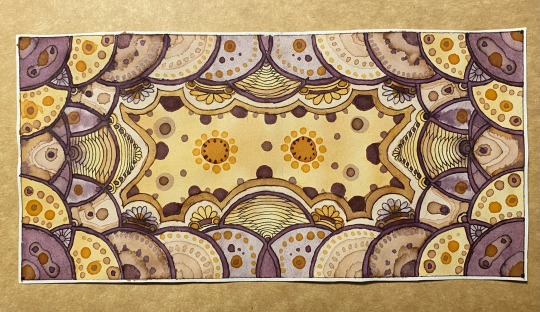
#art#crafts#paint#watercolors#orcein#lichen dyes#onion skin dyes#traditional art#natural dyes#I havent found any issues with ammonia/vinegar/baking soda reactions but i was also working with very small amounts#so while i am not confident enough to say it's safe for OTHERS to do im also cool with it myself#as there are no immediate chemical issues i can see looking into those three chemicals#or their reaction products and their reaction potential
78 notes
·
View notes
Text

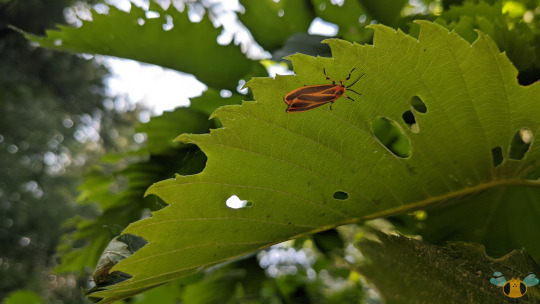
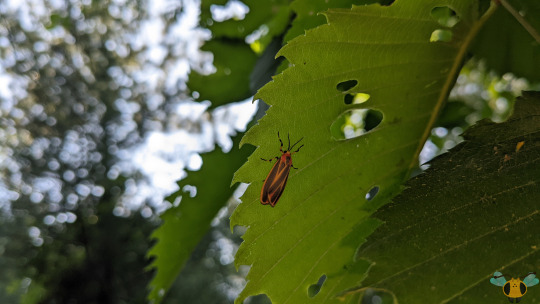
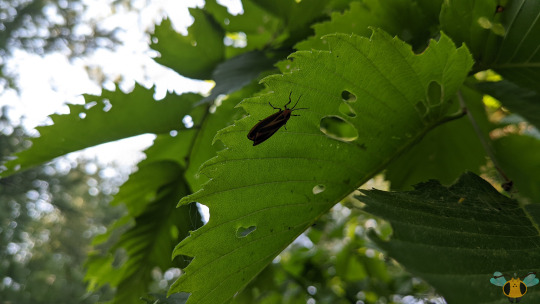
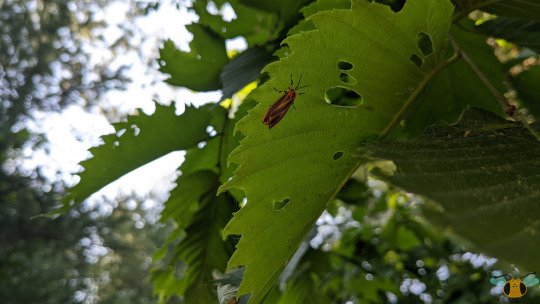
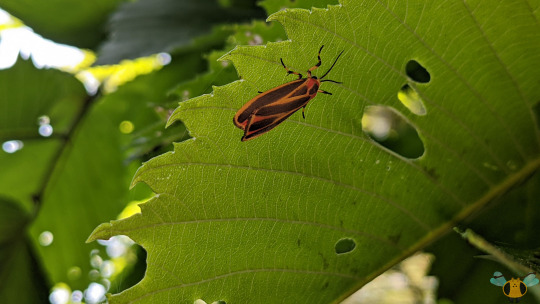


Painted Lichen Moth - Hypoprepia fucosa
The last time we saw this specie of Moth, an individual was hiding underneath a backyard umbrella until nighttime. Here we find a specimen in a more natural setting doing what resting adult Lepidopterans typically do when it's not their time of day to fly. Think about it: it's not as if Butterflies vanish into thin air or magic dust before nightfall arrives either. Since they lack set homes or shelters (and cannot make themselves flattened to hide underneath stones or roots), Lepidopterans conceal themselves against plants, trees or tree bark or by hanging underneath leaves. With this strategy, Moths and Butterflies (and other insects) can rest until it's time to become active. Of course, since they can't close their eyes, it's closer to a dormant state than what we mammals would clean sleep. In any case, by hiding insects like this can avoid a majority of predators. In retrospect, I was likely bothering this Moth with the phone's flash, but it didn't move a single inch while I photographed it. What a beautiful insect, wouldn't you agree? Having only seen this Moth twice in my life, I was renewed with how dazzling its striking yellow, black and red coloration is. Interestingly, two of the three relatives within the Hypoprepria genus all share this striking coloration and combination of shapes and patterns along their wings.
Specifically H. cadaverosa (which is mostly all yellow) and H. miniata which is mostly all deep-red to orange, hence its common name, the Scarlet-Winged Lichen Moth! While reading into the other species and looking for the ranges and means of identification, I happened across a post on iNaturalist (written by gcwarbler) that warns against the simplification of identifying these Tiger Moths and how wing color isn't the only identification factor, but it is used as a big shortcut very often and yet it can be extremely variable depending on region. Reading it, I thought about some of the identification methods I use and how although I do take a shortcut every now and then, I give my best effort to ensure all insects shared here are identified and described as accurately and truthfully as possible. Case in point, the iNaturalist post describes that for generalizations, it appears the Scarlet Moth has deep-red wings and also lacks a grey spot atop its thorax. Meanwhile our Painted Lichen Moth friend has only faint traces of scarlet across mostly yellow wings and a defined thoracic spot. Even then, variability means these features are not a guarantee, so it's important to follow identification keys, carefully observe insects and also their range.
Pictures were taken on July 9, 2022 in Kleinburg with a Google Pixel 4. For reference, I recommend reading gcwarbler's post on iNaturalist and applying it to your insect identifications. Especially if you live near Texas where Hypoprepia Moths are difficult to separate, which is to say nothing of the other Moths on higher taxonomic branches. What a (potential) mess indeed! If anything, it's best not to rush insect identification and consider as much available information as possible. Perhaps we should also consider hybridization or subspecies in the future if variation between individuals would become too great.
#jonny’s insect catalogue#ontario insect#moth#painted lichen moth#tiger moth#lepidoptera#insect#kleinburg#july2022#2022#entomology#nature#invertebrates#arthropods
15 notes
·
View notes
Text

Updated: 2023/12
I originally posted this on my old blog. Since posting that, I've found other foods, drinks and ingredients. As of now this list is updated with everything found in media released as of Oct 2023.
Like the original, this is still a very long post that contains all canonical desserts, dishes, drinks, ingredients, and sauces. Unlike the original, I could not list canonically suggested food and ingredients, nor every codex, item, letter, ect in the sources. Because it was too long. I did add them to the individual post.
Like in the individual posts, the list has the country of origins next to each item and any relevant information. Such as ingredients, use, notes, or trivia. For the canonically suggested foods and drinks I list what their real world uses are for your reference as to what they might be used for in Thedas.
For Shorter Food Posts
Dishes, Sauces, and Sides
Drinks
Raw Ingredients
Prepared Ingredients
Canonically Possible Foods and Drinks
Disclaimer
Though real life plants may be listed here as edible it is for fictional use only. This is not intended to be used as a reference nor guide for what plants are edible or safe to eat. Please do not use it as such.
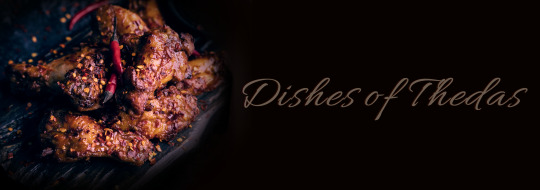
Dishes
Breads
Bark Bread
Biscuit
Whole Grain Biscuit - Commonly made in Chantry cloisters. A staple in their simple diets.
Black Bread
Braided Honey and Date Bread (Anderfels)
Brown Bread
Buns
Butter Puff - Bread made by folding butter into the dough allowing it to become puffy and softer than usual bread. (Orlais)
Crumpet
Dark Bread
Dried Bread
Flat Bread - A no-rise bread. Served with dip, brushed in oil, and/or as a side. (Nevarra)
Honey Loaf
Lichen Bread - Bread that is made using lichen. (Orzammar)
Black Lichen Bread
Peasant Bread - Comprised of wheat, grease, and salt in equal measure, made by Dalish and city elves in Orlais. They top it with butter, jam, and sometimes sugar. (Elves - Orlais)
Pumpkin bread - A favorite of Dorian Pavus (Tevinter)
Raider Queen’s Bread of Many Tongues - Created by the Raider Queen, this bread calls for flour, baking powder, salt, butter, brown sugar, molasses, eggs, bananas. The creator calls for Par Vollen bananas but another version of the recipe says Rivaini bananas are an acceptable replacement. (Rivain)
Rolls
Bread Roll
Sweet Rolls
Ryott Bread - Made of a protein rich grain called ryott. (Ferelden, Chasind)
Sweet Bread
Thin Bread - A thin bread used to make wraps in Seheron.
Whole Grain Bread - Another staple made in Chantry cloisters.
Wraps - Described as "soft" bread.
Appetizers, Starters, and Refreshments
Blood Orange Salad - a salad of bitter greens with blood orange slices served on top. (Nevarra)
Canapé - a type of hors d'œuvre.
Couscous Salad - A salad comprised of couscous with many varieties, one such variety includes red bell peppers and mint. (Rivain)
Crab Cakes - a classic dish in Kirkwall. (Kirkwall)
Dried Bread and Fruit
Eggs à la Val Foret - An egg dish served with a cream sauce. (Orlais)
Fluffy Mackerel Pudding - Celery, pepper, mackerel, diced onion, mustard, salt, Antivan pepper, ground mace, cardamom seed, eggs. Also known as Feast Day Fish (Ferelden)
Fried Crab Legs - A subsitute for the Orzammar dish of fried young giant spiders.
Fried young giant spiders - A common food in Orzammar, usually served with an alcohol-based sauce that varies with every establishment. (Orzammar)
Roasted Cave Beetles - Roasted whole and eaten out of the shell. (Orzammar)
Roasted Prawns - A substitute to cave beetles, said to have the same taste and texture.
Shredded Dried Meat and Cheese - A dish that is commonly used as a spread by the dwarves and used for lunches. (Orzammar)
Snails Dressed in Butter and Oil (Avvar)
Snails and Watercress Salad - A non-traditional dish inspired by Avvar cuisine featuring snails and watercress to appeal to lowlander pallets.
Stuffed Deep Mushrooms - A dish derived from various Orzammar deep mushroom delicacy. This Fereldan creation is stuffed with cheese and spinach. (Ferelden)
Rations, Tavern Fare, and Travel Food
Beer Nuts (Kirkwall)
Bread and Cheese
Chicken Wings - Sold in The Rusted Horn as ‘Wyvern Wings.’ (Ferelden)
Crow Feed (Antiva)
Dried Foods
Dried Fruit
Dried Meats
Fereldan Hearty Scones - a scone filled with bacon and cheese, careful, a mabari might snag it. (Ferelden)
Fish Pockets - A meal of fish, crisp vegetables, spices, and a soft wrap.(Seheron)
Fish Wrap - Fish wrapped in thin bread (Seheron)
Grey Warden Pastry Pockets - A hand pie filled with meat and other foods. Olesian Grey Wardens put their own twist using Olesian puff pastry.
The Hanged Man's Stew - The tavern’s featured dish, made with a different mystery meat every morning. (Kirkwall)
Jerky
Jerky Ball
Spiced Jerky
Meat Skewers - A portable snack. A known Orlesian version of this snack is primarily eaten by nobles while out on hunts and are not interested in the hunt, made of meat, cheese, and wine-soaked fruit.
Pickled Eggs - Eggs, sugar, salt, vinegar, and various spices and seasoning of the cooks preference. Favored in Ferelden and seen as a cure all. Served in nearly every Fereldan tavern. (Ferelden)
Pig Oat Mash - A constant dish on The Hanged Man menu, a popular hangover cure if washed down with brandy spiked cider. This warming porridge contains apples, dried salt pork or smoked bacon, dried rolled oats, berries, ale or water (Kirkwall)
Poison Stings - "Poison stings" is the colloquial name. Orange peels coated in chocolate, a crunchy yet chew texture that is both sweet and sour. A favored snack of Dorian Pavus when traveling from Tevinter to Ferelden. (Tevinter)
Provisions and Rations - Typically consist of dried meat, nuts, and a variety of other simple foodstuffs.
Dry Ration
Hardtack
Qunari Ration
Stuffed Vine Leaves - Common tavern food in Tevinter, stuffed with rice, herbs, and sometimes minced meat. Can be topped with lemon juice or tzatziki sauce.
Treviso Energy Balls - Made of peanut butter, oats, and dried fruit, it is a famine food invented during the occupation of Treviso in the Qunari Wars/The New Exalted Marches.
Unidentified Meat - Despite it's ominous name, it's simply chicken legs. Sometimes served with Nevarran flat bread. (Tevinter)
Dips, Glazes, Gravy, and Sauces
Apples Stewed in Brandy Sauce
Applesauce
Cherry Sauce
Cheese Sauce
Cream Sauce
Deep Mushroom Flavored Cream Sauce - Commonly served with seared nug. (Orzammar)
Dragon’s Blood Sauce (Nevarran)
Gravy
Honey-glaze - A sauce used to glaze various foods, particularly meats.
Hot Sauce
Llomerryn Red Sauce - A sauce that goes on almost everything, contains pulped tomatoes, onions, red pepper, brown sugar, apple cider vinegar, mustard powder, hot pepper powder, salt, cinnamon stick, allspice, cloves, fennel seeds, dill seeds, mustard seeds, black peppercorns, bay, garlic. (Rivain)
Mushrooms cooked in ale - One recommendation for this sauce is to be served over roasted nug.
Mushroom Sauce
Nesting Roast Gravy - Gravy made from the pan juices of a nesting roast. Meant to be served with the roast. (Orlais)
Plum Sauce
Red Wine Marinade
River-herring Gravy - a gravy as white as apple blossoms. (Orlais)
Special Sauce - A sauce infused with the essence of fifty-two herbs, prized for the ability to help with “inadequacy”. (Kirkwall)
Spider Leg Sauce - a variety of alcohol-based sauces unique to each Orzammar establishment, meant to be paired with fried young giant spider legs.
Tzatziki Sauce - Served with stuffed vine leaves. (Tevinter)
Wild Flower Glaze - A honeyed glaze made of wild flowers, it is recommended to use flowers plucked at dawn and the lowest blossoms. (Anderfels)
Yogurt Dip - Often served with flat bread (Nevarra)
Soups and Stews
Barley Soup
Blood Soup - Merrill is credited with the creation of this creamy beetroot soup, it is topped with roasted chickpeas. (Dalish)
Butter Soup - A simple, inexpensive, and easy soup. Made as midmorning meals or midday refresher for field workers. It is commonly fed to children and convalescents due to its nutritious nature. Ingredients include water, potatoes, cinnamon, star anise, clove, bay, peppercorns, salt, noodles, cream, butter (Orlais)
Cabbage Stew (Ferelden)
Deepstalker Stew - A stew of deepstalker is made when rations run low. (Legion of the Dead)
Denerim-rabbit Stew - Made with rat (City Elf)
Enchantment Soup - Made by Sandal, edibility unknown.
Fereldan Potato and Leek Soup
Fereldan Turnip and Barley Stew - White beans, oil, onion, carrots, celery, garlic, stock, turnips, turnip greens, sausage, barley, cumin, dried basil, oregano, salt, pepper, herbed wine vinegar
First Day Festival Stew (Orzammar)
Fish Chowder (Antiva)
Fish Stew
Lamb and Pea Stew - Alistair has his own version of this soup. (Ferelden)
Lentil Soup - A universal soup, with lentils being common in every Thedosian pantry.
Nettle Soup
Norbotten Fruit Stew - This dish is used to rehydrate dried fruits: dried apricots, pitted prunes, raisins, mixed dried fruits (cherries, apples, cranberries, etc), lemon or orange, cinnamon, cloves, water, sugar or honey, brandy. (Anderfels)
Pea Soup
Ram Stew (Ferelden)
Sweet and Sour Cabbage Soup (Ferelden)
Turnip Stew (Ferelden)
Turnip-Goat Stew (Ferelden)
Wild Rabbit Stew
Main Course
Alamarri Pickled Krone - Krone, Brine, (optional) pine pitch and druffalo dung.
Baked Fish - An Avvar cooking method where they wrap fish in pungent leaves and clay before cooking it in banked coals. (Avvar)
Baked Krone with Honey - The honey is typically used as a side sauce for dipping. (Fereldan)
Beans and Bread
Boiled Roots
Braised Nug with Elfroot (Dwarven)
Braised Ram with all the Trimmings (Ferelden)
Broiled Boar Head (Fereldan)
Cacio e pepe - A dish of three ingredients; spaghetti, pepper, and pecorino romano. (Antiva)
Dalish Deep Forest Comfort - String squashes, halla butter, garlic, mushrooms, elfroot or spinach, diced tomatoes or beetles, hot red pepper, rock salt, halla cheese or goat cheese, edible wildflowers (borage, chicory, etc), pine nuts. (Dalish, Southern Orlais)
First Day Chicken - a dish served during First Day in some parts of Orlais. (Orlais)
Fish in Salt Crust - Cooked much liked the baked fish, instead of using clay, the fish is covered in salt and wrapped in pungent leaves before being cooked in banked coals. (Avvar)
Fresh Oyster - Noted to go well with Llomerryn red sauce.
Fried Fish
Fried Mush (Orzammar)
Glazed Krone (Ferelden)
Gilded Swan with River-herring Gravy - An eastern spice, flour, gold leaf, river herring, swan, yolk. (Orlais)
Gnocchi (Antiva)
Goat Custard - A broiled goat head, not to be confused with the dessert. (Ferelden)
Grilled Poussin - Grilled chicken, typically a younger chicken. (Chasind)
Ham
Anderfels Smoked Ham - It tastes of despair
Avvar Ham
Ham Stuck with Cloves
The Jade Ham - Honeyed with wild flowers (especially those picked at dawn), masterfully seasoned, and spiral-cut. Not considered edible but better used as a weapon. (Anderfels)
Orlesian Ham
Smoked Ham
Herbed Chicken and Biscuits (Ferelden)
Jellied Meats
Jellied Pigs Feet - A delicacy in the Free Marches and originally a popular commoner food that has risen to the tables of nobility. Pigs feet and/or pork hocks, salt, onions, garlic, allspice, peppercorns, bay. (Free Marches)
Veal Galentine (Orlais)
Liver
Lutefisk
Nesting Roast - This dish is classically made with a quail stuffed in a pheasant stuffed in a swan. Served with gravy made from the pan juices. (Orlais)
Mad Burnard’s Gift of Flesh - A nesting roast unlike any other, involving a whole wyvern, stuffed with a whole gurn, stuffed with a horse, stuffed with a large halla (horns and all), stuffed with a swan, stuffed with a duck, stuffed with a quail, stuffed with a bunting that choked on a gold piece. (Orlais)
Nug Steak (Orzammar)
Nug-gets (Orzammar)
Nug-loaf (Orzammar)
Nug-Nug - A dish meant to resemble a nug peeking from its burrow; made of ground meat (beef preferred), parsley, egg, salt, crushed cumin or mustard seeds, black pepper, cooked rice, tomatoes, onions, chives (Orlais)
Paella - Made with rice, saffron, and a variety of seafood; such as shrimp, cuttlefish, and mussels. (Antiva)
Pancake - The breakfast food and savory dishes.
Crepes - A very thin pancake that can be filled with sweet or savory ingredients. (Orlais)
Hearth Cakes - Described as a common fare where they are baked on an iron griddle. They are made with halla butter (can be subbed for goat or cow butter), flour, hardwood ash (can be replaced with baking powder), cinnamon, ginger, nutmeg, sugar, mixed dried fruit (like cranberries, raisins, and currants), an egg, and milk. Described as baeing crispy and flaky on the outside, but remains moist on the inside. They are grilled on one side and then are flipped over, ensuring they are all crisp and bown. (Dalish)
Nug Pancakes - A savory pancake made with nug. A favorite among dwarven children. (Orzammar)
Porridge
Bland Porridge
Deer Porridge - A savory porridge served with deer.
Porridge with Raisins
Savory Porridge - Served with meat, vegatables, or spices.
Pudding - A sweet or savory, steamed dish that can be topped with gravy or chocolate.
Rack of Ribs (Ferelden)
Ram Chops (Ferelden)
Ram Cutlet (Ferelden)
Rice and Boiled Vegetables (Tevinter)
Roast
Gurgut Roast with Lowlander Spices and Mushroom Sauce (Avvar)
Roast Boar - One cooking method involves the boar being stuffed with apples (Ferelden and Orlais). Another has it served with a side of candied yams.
Roast Chicken
Roast Duck
Roast Hog
Roast Lamb
Roast Turkey - Common in the Free Marches, especially among Starkhaven nobility, as well as the Chasind.
Roast Wyvern - Common with the Avvar and Orlais.
Roasted Cave Beetle (Dwarven)
Roasted Giant Spider (Dwarven)
Roasted Nug (Orzammar)
Roasted Phoenix - One of the most infamous meals in Thedas, it is served with sweet red wine.
Roasted Rabbit
Roasted Venison with Wild Greens - The venison is seasoned with mint and pepper, served with wild greens and sweet pastries. Paired with wine to drink. (Ferelden)
Slow-roasted Nug-let (Orzammar)
Spit-roasted Deepstalker (Dwarven)
Spit-roasted Nug with Hot Sauce (Orzammar)
Sandwich
Ham Sandwich
Sausage - There are about twelve different kinds of sausage unnamed mentioned in Last Court.
Black Pudding - A type of blood sausage made from pork or beef blood, pork fat or beef sue, and a type of cereal. (Orlais)
Smoked Sausage
Spiced Sausage
Savory Pies
Dove Pie - A pie made with live doves, for the theater of the meal. (Orlais)
Nug Bacon and Egg Pie (Ferelden)
Pigeon Pie
Pork Pie
Starkhaven Fish and Egg Pie - Fish from the Minanter River (carp, trout, or others), wine, onion, carrot, thyme, bay, sea salt, dried currants, sliced almonds, boiled sliced eggs, butter, flour, fish broth, milk, salt, pepper, nutmeg, cream, fried whitebait or other small fish. (Starkhaven)
Turnip and Mutton Pie (Ferelden)
Unmentionable Pie - It is a meat pie that uses the typically undesirable parts of an animal. (Ferelden)
Venison Pasty - A hand pie filled with venison. In Serault, it is served with curls of goat cheese. (Orlais)
Seared Nug - Usually served with a deep mushroom cream sauce. (Orzammar)
Simmering Partridge - Cooked with sweet onions and pale beans (Orlais)
Smoked Meat
Smoked Boar
Smoked Fish
Smoked Rabbit
Smoked Venison
Spiced Nug
Stuffed Cabbage - A seasoned cabbage head stuffed with meat.
Venison with Apples Stewed in Brandy Sauce
Wandering Hills - A delicacy made from large creatures of the same name. (Anderfels)
Wyvern Steak
Sides
Antivan Olives - Soaked in vinegar and stuffed with capers.
Boiled Turnip (Ferelden)
Brandy Soaked Cherries (Orzammar)
Candied Yams
Croutons
Fried Potatoes - Recommended to be served with Llomerryn red sauce.
Hard-boiled Egg
Honey Carrots - Most common in Orlais where it is traditionally sweeter compared to other places due to the use of honey.
Jarred Olives (Tevinter)
Jellied Eels (Ferelden)
Mashed Turnip (Ferelden)
Peeled Grapes (Tevinter)
Picked Foods
Pickled Apples
The Pickled Apples of Arlathan - Apples said to be from the time of Arlathan. The taste is described to be one of fresh apples, with the same crispness.
Pickled Fish
Pickled Lamprey
Pickled Nug
Pickled Ox Tongue
Pickled Vegetables
Pickles
Roasted Chestnuts (Nevarra)
Roasted Figs (Rivain)
Roasted Potatoes - Recommended to be served with Llomerryn red sauce.
Roasted Turnip (Ferelden)
Sera’s Yummy Corn
Smoked Bacon
Steamed Beans
Steamed Turnips (Ferelden)
Stir-fried Turnips (Ferelden)
Toast
Toasted Bread - Used for dipping in stews.
Toasted Chickpeas - Used as a topping for soups and salads, sometimes as a replacement for croutons.
Wine Soaked Fruit
Baked Goods, Desserts, and Sweets
Bread Pudding - Made with stale bread, eggs, milk or cream, and other ingredients varied by if it is savory or sweet (Ferelden)
Cake
Cake with Apples
Cake with Nutmeg
Chocolate Cake
Cupcakes
Cherry Cupcakes - Historically a common method used to poison people, often served in the theater. (Tevinter)
The Exquisite Misery - A little cake topped with a dusting of anise, deep mushrooms, and gold dust. (Orlais)
Found Cake - A chocolate cream cake topped with white frosting and strawberries (Ferelden)
Hearth Cake - A pan-made cake; made of flour, hardwood ash or baking powder, halla butter, sugar, mixed dried fruit (currants, cranberries, etc), egg, milk. (Dalish)
Honey Cake (Orlais)
Lamprey Cake - contains no actual lampreys, it is modeled after the appearance of lamprey.
Lemon Cake
Petit Fours (Orlais)
Pound Cake
Round Cake - Often topped with poppyseed and honey. In Serault, they will sometimes have the antlers baked into the crust. (Orlais)
Sponge Cake (Orlais)
Sugar Cake - One version is made with strawberries and sugar-cream icing dressed on a pound cake. (Ferelden) Another version is made with a "humble cake" and is dressed with butter, sugar, and almonds. Both are seen as great gifts and good pick-me-ups after long days of traveling, and are often served by merchants.
Sugar-drizzled Lemon Cake - A type of lemon cake that was used in Antivan Crow history to assassinate templars.
Sugarcake - A dense cake usually topped with powdered sugar.
Sweet Cake
Wedding Cake
Candy
Black Licorice Candy - Can be salted. (Tevinter)
Bon-bons
Candied Almonds
Candied Fruit
Candy Apple (Ferelden)
Candied Dates (Tevinter)
Candy Cane
Carastian Candy - A candied chocolate. (Tevinter)
Peppermints
Spun Sugar (Ferelden)
Sweetmeat - A confectionery treat, sometimes candy coated fruit.
Toffee
Unnamed Candied Nuts with Spice - A candy that is sweet until swallowed, then they leave a spicy aftertaste. (Orlais)
Cobbler
Dalish Forest Fruit Cobbler
Strawberry and Rhubarb Cobbler (Ferelden)
Cookies
Biscuit - A hard, flat, and unleavened baked treat that can be sweet or savory.
Butter and Sugar Cookie - This cookie isn’t specified as it is only described by these ingredients.
Raisin Cookies
Shortbread
Tea Biscuits
Wafers
Custard
Goat Custard - Differing from the Fereldan savory counterpart. This custard is made throughout Thedas with goat milk and has numerous varieties. On pairs it with roast fig. A Rivain variation uses milk of the Ayesleigh gulabi goats specifically for its sweeter milk.
Donuts
Ice Cream
Orlesian Guimauves - Another name for marshmallows.
Pastries
Antivan Apple Grenade
Cinnamon Rolls - one of Varric's favorite pastries.
Croissant - Vivienne starts every morning with one. (Orlais)
Honey and Nut Pastry (Tevinter)
Macaroon
Marie du Lac Erre’s Sweet Ruin - One version of this pastry with a dramatic history, the recipe contains; butter, powdered sugar, chocolate, vanilla extract, flour, orange or mint extract, baking powder, and milk. (Orlais)
Tarts
Unnamed Blueberry Pastry - A light, sticky pastry with blueberries. (Possibly Nevarra)
Varric's Favorite Pastry - A pastry spread created by Devon, a Fereldan cook, after consulting with Varric Tethras on his favorite pastry.
Pie
Apple Pie
The Blessed Apple - A pie made by a small cloister of Chantry sisters tending to the orchard, they use the windfall apples and share the pies freely; as well as the apples. The ingredients are flour, salt, butter, water, apples (golden apples from Lady’s Orchard preferred but others are acceptable substitutions), brown sugar, salt, cinnamon, nutmeg, and cloves. (Orlesian)
Minced Pie - filled with finely chopped fruit and sweet things.
Pudding
Blancmange - A white pudding made of milk or heavy cream, its name is Orlesian for "white eating". Because of the mild, sweet taste it can have a variety of toppings such as toasted almonds, ribbons of fresh mangos, red grape compote, cherry saus, or Vivienne's preferred plating of white chocolate curls with whole jasmine flowers. (Orlais)
Caramel Pudding
Dessert Pudding
Rice Pudding
Scones
Sour Cherries in Cream (Orlais)
Sticky Figs Rolled in Nuts (Tevinter)
Sticky Jellies (Orlais)
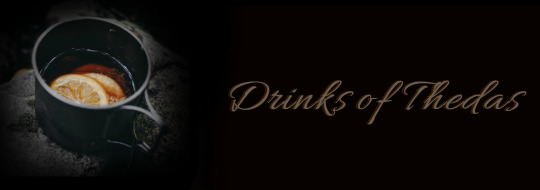
Drinks
Absinthe
Absence - One of the bottles of Thedas you find in Inquisition.
Absinthe - also referred to la fée verte - “little green fairy”
Petite Absinthe - Made from a certain type of wormwood.
Ale, Beer, Drafts, Lagers, Malts, and Stouts
The Tapster’s Tavern in Orzammar serves 52 types of ale, some are listed.
Ale
Ander Stout - This stout is stored in oak casts. (Anderfels)
Barley Wine - Despite its name, this is an ale.
Beer
Brakien Brew (Orzammar)
Brown Ale
Coconut Draft (Orzammar)
Fereldan Beer
Fereldan Lager - A pale ale.
Lichen Ale (Orzammar)
Lichen-malt (Orzammar)
Oghren’s Homebrew - An amber coloured ale with a slightly sweet, nutty flavor and described to have a hint of toastiness, and is spiced with cloves. (Dwarven)
Qunari Ale
Ryott Ale (Ferelden)
Ryott Beer (Ferelden)
Valenta’s Red (Orzammar)
Watered Beer - While watered beer is served to reduce the price of beer and stretch it along, it is also served as a provision. In Serault, the peasantry drink watered beer to stave off the summer heat.
Watered-down Ale
Wildwine - An ale made from ryott. (Chasind)
Wilhelm’s Special Brew - This dark-colored ale gives off a thick, oaky smell. When swirled in its tankard, it takes on an unexpected glow. (Ferelden)
Brandy
Ammazzacaffe - A drink taken after coffee to dull the taste or effects. Though it can be a small glass of any liqueur, it is usually brandy. (Antiva)
Aged Antivan Brandy
Antivan Brandy
Antivan Plum Brandy
Apple Brandy (Orlais)
Orlesian Brandy
Plum Brandy
West Hill Brandy (Ferelden)
Cider
Brandy-spiked-cider
Cider
Serault Cider (Orlais)
Winter Cider (Wycome)
Cocktails
Benediction - Made of Prophet's Larel gin, served with a wedge of lime, and a thimble of Golden Scythe.
Elfroot mixed with Dandelion Wine - A restorative draft. (City Elves of Orlais)
The Emerald Valley - A spirit distilled of over seventy different herbs and flowers by the Chantry sister in Lydes, it is topped with egg-white foam and dusted with nutmeg. Described as having a varied and complex flavour, fresh like a lush green valley. (Orlais)
Dragon’s Piss - The name is probably figurative, but no one knows for sure. BioWare gives the “recipe” for Dragon Piss as “1 oz light rum, 1 oz dark rum, filled with iced tea”. "Dragon's Breath" is offered as an alternative name for this drink as it is served while lit on fire in the glass and burns on the way down.
The Golden Nug - Made with a base of effervescent white Seleney wine, sweetened with a dash of West Hill brandy and a splash of pomegranate juice. Muddled with raspberries and garnished with a sprig of Royal Elfroot. The goal is to imitate the soft pink colour of a nug.
The Heart of Spring - A “restorative” drink from Verchiel made with violets. (Orlais)
The Hissing Drake - Mix of cinnamon-infused whiskey, darl Llomerryn rum, and Hirol's Lava Burst.
Ice Cream and Beer
A Night of Shame - Antivan port with a dash of chocolate bitters and a twist of orange, served in a flute of chilled Serault glass. (Orlais)
Orichalcum mixed with wine - Considered to have aphrodisiac properties.
Posset - A drink made of hot milk curdled with ale, wine, or other liquor and typically flavored with spices. Can be drunk as a delicacy or as a cold remedy.
The Randy Dowager - Rumored to be created by the editor of the periodical, it is a tall glass of Abyssal Peach liquor and fresh cream, garnished with sugared rose petals and served on a silk handkerchief with a scandalous rhyming couplet inked by the bartender. (Orlais)
To Cure a Cold - a folk remedy that requires boiling whiskey and adding lemon juice and crushed garlic.
Gin
Gin
Prophet’s Laurel Gin (Orlais)
Grey Warden Liquor
These are bottles unique to members of the order, as each warden will combine half-full bottles in order to save space. No bottle is ever fully emptied or cleaned. In order to preserve the base flavor. They are called Grey Whiskey, Ritewine, or Conscription Ale, each vintage is named after a warden with a small note.
Vintage: Warden Anras - Bottled whimsy.
Vintage: Warden Bethany Hawke - Princess piss.
Vintage: Warden Carver Hawke - Toast them all.
Vintage: Warden Daedalam - Extra red.
Vintage: Warden Eval’lal - Griffon Wing Ale
Vintage: Warden Gibbins - Don’t frigging touch! I spit in this! I mean it!
Vintage: Warden Jairn - Smash when dead.
Vintage: Warden Korenic - Notes of fruit and anger.
Vintage: Warden Riordan - Serve yourself.
Vintage: Warden Steed - Joining juice.
Vintage: Warden Tontiv - Home.
Mead
The Tapster’s Tavern in Orzammar serves 17 types of mead, some are listed. Honeywine is another name for mead.
Avvar Mead
Chasind Sack Mead
Lady Odette Guillory’s Family Honey Wine (Orlais)
Mead
Orlesian Honeywine
Port A sweet, fortified red wine, typically served with dessert.
Antivan Port
Tevinter Port
Rum Boot Screech is another name for rum.
Alvarado’s Bathtub Boot Screech
Blackwater Rum (Wycome)
Dark Llomerryn Rum
Tea and Other Drinks
Coffee (Antiva)
Cocoa/Hot Chocolate
Juice
Fermented Fruit Juice
Pickle Juice
Pomegranate Juice
Prune Juice
Punch
Spicy Punch
Tea
Almond Tea (Orlais)
Bitter Tea - An unspecified tea so bitter it is astringent. Served during the Fourth Blight.
Black Tea
Black Tea with Juniper
Fires of Change Tea (Orlais)
Herbal Tea
Iced Tea
Lattenfluss Tea (Anderfels)
Mint Tea
Anderfels Mint Tea
Nameless Tevinter Tea
Rivaini Spice Tea Blend - Blend of cinnamon, ginger, and cloves. One of the teas from Rivain known for its healing properties. Empress Celene commonly uses this tea to stave off headaches.
Rivaini Tea
Rivaini Tea Blend - A blend of licorice root, oregano, lemon verbena, and peppermint. One of the teas from Rivain known for its healing properties. Rumored to be favored by Empress Celene to stave off headaches.
Rosehips Tea (Orlais)
Spiced Tea (Nevarra)
Stripweed Tea (Tevinter)
Unsweetened Tea
Verimensis Tea (Tevinter)
Whiskey
Cinnamon-infused Whiskey
Ferelden Whisky
Legacy White Shear
Mackay’s Epic Single Malt
Wine
The Tapster’s Tavern in Orzammar serves 12 types of imported wines, some are listed.
Agreggio Pavali (Tevinter)
Alyons Black (Orlais)
Amaranthine Red (Ferelden)
Anderfels Red
Antivan Red
Bitter Black Wine (Orlais)
Bottled Scar 5:34 Exalted - A rare collaboration between human and elf vintners.
Celestine Black Wine (Orlais)
Dalish Wine
Dandelion Wine (City Elves of Orlais)
Elderberry Wine (Ferelden)
Finale by Massaad (Orlais)
Flames of Our Lady (Orlais)
Flat Wine
Ghislain Red (Orlais)
Iced Wine - Mentioned in both Tevinter and Orlais.
Montsimmard White (Orlais)
Mosswine (Orzammar)
Mulsum (Tevinter)
Orlesian Red
Plum Wine
Red Wine
Serault Yellow Wine (Orlais)
Serault White (Orlais)
Silent Plains Piquette (Tevinter)
Southern Black Wine
Spiced Wine
Sweetened and Spiced Yellow Wine
Val Chevin Red Wine (Orlais)
Vint-9 Rowan’s Rose (Tevinter)
Watered Wine
White Seleny Wine (Antiva)
White Wine
Yellow Wine
Additional Spirits
Abyssal Peach
Antivan Sip-Sip
Aqua Magus
Aquae Lucidius - A potent liquor made of wyvern venom; a rare drink known for its hallucinogenic properties.
Bottle of Rotgut - Rotgut is slang for cheap whiskey.
Butterbile :84
Carnal 8:69 Blessed (Orlais)
Dwarven Ale - Not actually an ale, but a black liquid reputedly made from fungus with a reputation as being almost undrinkable for anyone not a dwarf.
Garblog’s Backcountry Reserve
Golden Scythe 9:40 Black
Hirol’s Lava Burst (Kal'Hirol)
Maraas-Lok (Qunari)
Moonshine
Potent Moonshine
Sun Blonde Vint-1 (Tevinter)
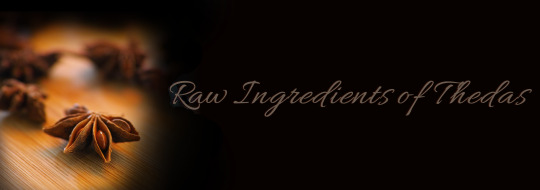
Raw Ingredients of Thedas
Fruits, Mushrooms, Nuts, and Vegetables
Edible Plants
Bark
Fern Fiddlehead (Avvar)
Hops
Lichen (Dwarves)
Black Lichen - Toxic unless properly cooked.
Moss (Dwarves)
Nettle
Pungent Leaves - Unspecified leaves. (Avvar)
Rose (Orlais)
Rose Petals
Rosehips
Stripweed (Tevinter)
Sugar Cane (Orlais, Tevinter, Rivain)
Vine Leaves (Tevinter)
Watercress (Avvar)
Wildflowers
Borage
Chicory
Dandelion
Honeysuckle
Jasmine
Violet
Fruits and Nuts
Apple
Applewood Apples (Orlais)
Golden Apples (Orlais)
Green Apples
Le Pomme Vie et Morte - Apples that grow by the gallows in Val Royeaux. (Orlais)
Red Apples
Windfall Apples
Apricot
Banana
Par Vollen Banana
Rivain Banana
Berry
Blackberry (Ferelden)
Blueberry
Cranberry
Currant
Black Currant
Elderberry (Ferelden)
Raspberry
Strawberry (Ferelden)
Caper (Antiva)
Cherry
Black Cherry
Sour Cherry - unspecified variety(ies)
Sweet Cherry - unspecified variety(ies)
Cocoa/Chocolate (Donarks)
Coconut
Coffee (Antiva)
Date - A purple and red fruit with a pit, it has a sweetness and tangy taste. (Tevinter)
Fig (Tevinter)
Grape
Red Grape (Orlais)
Lemon
Lime
Mango
Nuts
Almond
Chestnut
Pine Nut
Olive
Antivan Olive
Orange (Antiva, Orlais, Tevinter)
Blood Orange (Nevarra)
Passion Fruit (Antiva)
Peach
Pear
Plum
Pomegranate (Tevinter)
Pomegranate Seeds
Grain
Barley
Fereldan Barley
Pot Barley
Oats
Rolled Oats
Rice (Antiva, Rivain)
Ryott (Ferelden)
Wheat
Durum Wheat (Rivain)
Whole Grains
Mushrooms
Deep Mushroom
Field Mushroom
Unspecified Fungus - Used to brew Dwarven ale.
Truffle
Unnamed Glowing Fungus
Wild Mushroom
Vegetables and Legumes
Beans
Bush Beans (Free Marches)
Green Beans (Orlais)
Pale Beans (Orlais)
White Beans (Orlais)
Beet
Cabbage
Carrot
Purple Carrot (Orlais)
White Carrot (Orlais)
Celery
Chickpea (Rivain)
Chive
Corn
Checkered Corn
Golden Corn (Orlais)
Yellow Corn
Cucumber
Eggplant (Antiva, Ferelden)
Fennel (Orlais)
Leek
Lentils
Lettuce
Mustard
Onion
Red Onion (Orlais)
Sweet Onion (Orlais)
White Onion
Pea
Peanut (Antiva, Seheron)
Pepper
Antivan Pepper
Green Pepper
Hot Pepper
Hot Red Pepper
Red Bell Pepper (Rivain)
Sweet Pepper (Orlais)
Potato
Radish
Daikon Radish (Ferelden)
Rhubarb (Ferelden)
Spinach
Squash
Marrow Squash
Pumpkin
String Squash
Tomato
Turnip - aka navet
Turnip Greens
Wild Greens
Yams (Ferelden)
Animal Products
Dairy
Cream
Heavy Cream
Milk
Cow Milk
Goat Milk
Halla Milk
Ram Milk
Soured Milk
Eggs
Caviar
Chicken Egg
Fish and Seafood
Carp
Cod
Crab
Cuttlefish
Eel
Krone
Lamprey
Mackerel
Mussel
Oyster
Prawn
River Herring
Shrimp
Sunfish
Trout
Whitebait
Insects
Cave Beetle (Dwarven)
Giant Spider (Dwarven)
Scorpion
Snail (Avvar)
Wood-burrowing beetle larvae (Dalish)
Meats
Beef
Ox
Ox-tongue
Veal
Boar
Bronto (Orzammar)
Cat - mentioned to be eaten in Orlesian alienages by those most desperate (City Elves of Orlais).
Dog - mentioned to be eaten in Orlesian alienages by those most desperate (City Elves of Orlais).
Druffalo
Giant (Tevinter)
Goat
Gurn
Halla
Hare
Hart
Horse
Liver - General name given, animal isn’t specified.
Nug
Pork
Pig’s Feet
Pork Hocks
Pork Saddle
Rabbit
Ram
Rat - mentioned to be eaten in alienages by those most desperate (City Elves of Anderfels, Ferelden)
Sheep
Lamb
Mutton
Venison
Wandering Hills (Anderfels)
Poultry and Reptiles
Bunting
Chicken
Poussin (Chasind)
Deepstalker (Dwarven)
Dove
Dracolisk (Tevinter)
Dragon (Nevarra, Orlais)
Duck
Gurgut (Avvar)
Lurker (Avvar)
Partridge
Pheasant
Phoenix
Pigeon
Quail
Quillback
Swan
Turkey
Varghest
Wyvern (Avvar and Orlais)
Misc.
Dragon Blood (Nevarra)
Druffalo Dung
Honey
Honeycomb
Miscellaneous Ingredients
Baking Ingredients
Ash
Elfroot Ash
Hardwood Ash (Dalish)
Baking Powder
Yeast Cake
Salts
Fine-ground Salt
Rock Salt
Salt
Sea Salt
Others
Brine
Clay (Avvar)
Pine Pitch (Alamarri)
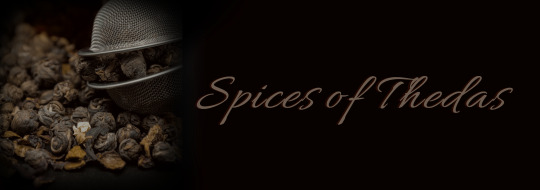
Herbs and Spices
Herbs
Basil - Mentioned to be grown in Serault, Orlais.
Dried Basil
Bay Leaf
Catsbane
Elfroot
Elfroot Leaves
Royal Elfroot
Lavender (Orlais)
Mint
Anderfels’s Mint
Foxmint
Peppermint
Oregano
Dried Oregano
Parsley
Prophet’s Laurel
Rosemary
Spindleweed
Verdant Spindleweed
Thyme
Spices
Allspice
Anise
Antivan Cord-seed
Cardamom
Cinnamon (Rivain, Seheron)
Clove
Cumin
Cumin Seed
Deep Mushroom Powder (Orlais and Orzammar)
Dill
Dill Seeds
Eastern Spice - Unnamed
Fennel
Fennel Seeds
Garlic
Ginger
Dried Ginger
Hot Pepper Powder
Hot Red Pepper, Crushed
Juniper
Licorice
Mace
Mustard
Mustard Powder
Mustard Seeds
Nutmeg (Seheron)
Grated Nutmeg
Ground Nutmeg
Pepper
Black Pepper
Peppercorn
Black Peppercorn
Poppyseed
Saffron
Spice Ball - A variety of mixed spices wrapped in a cheesecloth
Star Anise
Vanilla (Rivain)

Prepared Ingredients
Basic Ingredients
Alcohol
Brandy
Cinnamon-infused whiskey
Dark Llomerryn Rum
Hirol’s Lava Burst
Prophet’s Laurel Gin
Red Wine
Watered Down Ale
Whiskey
White Seleney Wine
Broth
Deepstalker Broth
Fish Broth
Butters - Non-dairy butters
Peanut Butter
Caramel
Cocoa Products
Chocolate (Orlais, Tevint)
Chocolate Bitters
Cocoa Butter - used to make white chocolate (Orlais)
Cocoa Powder - difficult to procure
White Chocolate (Orlais)
Compote - Fresh or dried fruit that is cut into chunks and stewed in a syrup of sugar and other flavours.
Red Grape Compote (Orlais)
Croutons
Custard
Dough
Pie Dough
Puff Pastry Dough (Orlais)
Extract
Mint Extract
Orange Extract
Vanilla Extract
Flour
Ryott Flour (Chasind, Ferelden)
Semolina Flour (Rivain)
Wheat Flour
Whole Grain Flour
Frosting
Buttercream
Chocolate Cream
White Frosting
Gold
Edible Gold Leaf
Gold Dust
Jam
Plum Jam
Raspberry Jam
Mulled Fruit
Mulled Raspberry
Oil
Cod Liver Oil
Orange Essence
Pasta
Antivan Pasta
Couscous (Rivain)
Gnocchi (Antiva)
Grain-based Noodle
Noodle
Pound Cake
Stock
Brown Stock
Sugar
Brown Sugar
Molasses
Powdered Sugar
Sugar-cream Icing
Sugar Flowers
Sugared Rose Petals
Syrup
Sugar Syrup
Tea Biscuit
Toffee
Wafer
Vinegar
Apple Cider Vinegar
Herbed Wine Vinegar
Dairy and Eggs
Butter
Cow Butter
Goat Butter
Halla Butter
Herbed Butter
Nug Butter
Cheese
Antivan Smoked Cheese
Blue-veined Cheese (Orlais)
Brie Cheese
Brined Goat Cheese
“Dalish” Cheese - An ill described item as it is unclear if it is actually cheese. One thing is for sure it isn’t Dalish.
Dry Cheese - Unspecified cheese used in cacio e pepe(Antiva)
Feisty Cheese (Orlais)
Goat Cheese
Halla Cheese (Dalish)
Ram Cheese (Ferelden)
Cream
Spiced Cream
Thickened Cream
Whipped Cream
Egg
Hard Boiled Egg
Yogurt
Dried and Cured Foods
Dried Fruits, Vegetables, and Fungi
Dried Apple
Dried Apricot
Dried Beans
Dried Cherry
Dried Cranberry
Dried Currant
Dried Mushroom
Dried Peas
Prunes
Pitted Prunes
Raisin
Cured Meats
Bacon
Nug Bacon
Smoked Bacon
Cold Cuts
Dried Meats
Dried Mackerel
Lutefisk
Jerky
Spiced jerky
Salted Meat
Dried Salt Pork
Salt Pork
Salted Beef
Salted Dragon Meat
Salted Fish
Salted Goat Meat
Sausage
Blood Sausage
Smoked Sausage
Spiced and Salted Sausage
Smoked
Smoked Beef
Smoked Fish
Smoked Goat Meat
Pickled Foods
Pickled Apples
The Pickled Apples of Arlathan - Apples said to be from the time of Arlathan. The taste is described to be one of fresh apples, with the same crispness.
Pickled Fish
Pickled Lamprey
Pickled Nug
Pickled Ox Tongue
Pickled Vegetables
Pickles
Prepared Animal Products
Gelatine
Grease
Ground Meat
Ground Beef
Ground Nug
Lard
Spiced Meat
Miscellaneous
Lyrium
Soup Bone
Wyvern Venom - There are 47 ways to distill wyvern venom to be safe for consumption.
Sources:
(If you want to find the direct links or page numbers, check out the Wiki's Food and Ingredients page.)
Primary Sources:
Dragon Age: Origins (Base and DLCs)
Dragon Age: Awakening
Dragon Age 2 (Base and DLCs)
Dragon Age: The Last Court
Dragon Age: Inquisition (DLCs + Multiplayer)
Books:
Dragon Age Tabletop RPG Core Rulebook
Dragon Age Tabletop RPG: Blood in Ferelden
Dragon Age Tabletop RPG: Game Master’s Kit: Buried Past
World of Thedas Vol. 1
World of Thedas Vol. 2
Dragon Age Official Cookbook: Tastes of Thedas
Dragon Age: The Stolen Throne
Dragon Age: The Calling
Dragon Age: The Masked Empire
Dragon Age: Asunder
Dragon Age: Last Flight
Dragon Age: Tevinter Nights
Short Story: Paper and Steel
Short Story: Paying the Ferryman
Short Story: Riddle in Truth
Short Story: As We Fly
Comics:
Silent Grove
Mage Killer
Knight Errant
Deception
Wanna support this blog? Check out my ko-fi.
#dragon age#food lore#foods of thedas master post#alcohol cw#food cw#drinks of thedas#foods of thedas#ingredients of thedas#thedosian foods#thedosian fauna#thedosian flora#anderfels#antiva#avvar#chasind#dalish#ferelden#free marches#nevarra#orlais#orzammar#rivain#seheron#tevinter#city elf#qunari#long post#archi is archiving#this post is so long I kid you not when da4 comes out I will likely have to make a whole separate post
32 notes
·
View notes
Text
Just some notes I am making for myself!!
Isopod Shopping List:
✔️ Glass aquarium/vivarium (ensure lid has fine mesh to keep out pests; a lid that's partially glass will make it easier to maintain humidity)
✔️ Humidity gauge/thermometer (50-60%, 70-85 degrees F)
✔️ Bark 'hides' and (safe) decorative pieces; cork bark is common
✔️ Squirt bottle for misting
✔️ Substrate (common ones: topsoil, coco fiber, coco chips, sand, charcoal, small pieces of bark/wood, sphagnum moss; the moss helps retain moisture and thus is handy but don't use too much; ensure the soil used has no fertilizer beads or other 'extras' in it):
✔️ Topsoil/Potting Soil
✔️ Worm castings
✔️ Fir Bark Chips
✔️ Charcoal
✔️ Sphagnum Moss
✔️ Dead leaves (primary food source; some people boil or bake them to sterilize but others don't; a variety of leaf types will work; some commonly used ones include maple, oak, birch, elm, cottonwood, etc; thinner leaves and older, more 'rotten' leaves are tastiest to them, but be sure to inspect for mold or hitchhikers; provide plenty of leaves in a layer over the whole tank)
Additional dead organic matter can include seed pods such as magnolia pods, lichen, or other goodies
✔️ Nutrient-rich foods (secondary food source; a variety of things can be used including fish flakes, dried bloodworms, dried shrimp, small pieces of produce scraps, specialized products such as Repashy Morning Wood and Repashy Bug Burger, etc) to be provided in very small amounts that can be eaten quickly and any excess removed before it molds; experiment to see how long it takes for them to consume it and what they prefer to eat
✔️ Cuttlebone (broken up) may be provided if desired for extra calcium
Springtails may be added to help control mold and pests
Isopod Care Notes:
Some keepers have a 'damp' side and a 'drier' side to allow the isopods to regulate their own preferences; sphagnum moss works good for the damp side, and situate a vent by the dry side if possible
Heat should not be needed unless your room is especially cool
Most keepers prefer deep substrate for the isopods to burrow, but some prefer shallower substrate so they can keep track of their stock better (they use a compacted substrate layer and place a looser, shallower burrowing layer on top)
Substrate does not need to be changed often but every few months is a good idea to refresh its nutrients and remove excess frass & ammonia buildup
Exact environmental preferences will depend on the species of isopod; while their needs are often very similar it's important to always double-check about your exact species
Isopods will reproduce readily (females carry the eggs in their bodies and will give 'birth' to live isopods) and the little babbies (mancae) start off very teeny so be careful when you're cleaning
Invert keepers have bred a TON of varieties of isopods, at differing 'difficulty' and price levels; make sure you are purchasing isopods that have been bred in captivity and not poached from the wild; and obviously never release pets into the wild
Some Beginner Isopods & Pretty Color Morphs:
Armadillidium nasatum (Nosy Pillbug): Peach, Orange, White Out/Pearl
Armadillidium vulgare (Roly-Poly): Orange Vigor, St. Lucia, Magic Potion
Porcellio scaber (Rough Woodlouse): Dalmation, Orange Koi, Lava
Porcellio laevis (Swift Woodlouse): Dairy Cow
Cubaris murina (Little Sea Isopod): Anemone, Glacier
Questions for Sellers:
Opinions on enclosures, especially with regards to maintaining proper moisture and airflow
Opinions on where to safely collect leaf litter (esp this time of year), boiling to sterilize (potential nutrition loss)
Species
Where do you get your isopods?
9 notes
·
View notes
Text
misc. temple headcanons
all temples have a main room (the boss fight room, for context) with lots of constantly lit candles (by followers) and a ritual circle in the center. this circle is important for the bishops to fully unleash their eldritch forms, as they cannot fully transform without a massive blood sacrifice. and they all have branching rooms, full of stuff. there's at least a room for offerings, a room for sermons, and a personal work/relax room.
-it's a nightmare to navigate leshy's temple
- tree roots, vines, all kinds of plants grow everywhere in it. leshy is pretty adept at swiftly weaving through all the clutter, but for followers and his siblings, it's a hassle. he is forced to make a clear pathway so his followers dont get frustrated trying to get in the main enterance.
- he often bonks his head trying to dig into his temple, he isn't quite strong enough to dig through stone in his normal form! he can still use his bishop warming power through it, but that isnt nearly as fun
- leshy has a massive arboretum. it branches off into different climates to house all kinda of flora from all regions of the old faith (except for stuff that only exists in the afterlife, because its impossible to get those)
-heket's temple is very rustic
- cottagecore type vibes, autumn cottagecore. the floor is always a bit damp because of how anura is. small mushrooms sprout through the cracks in the stone and moss/lichen is very common (though i should note, the moss/lichen in anura is yellow/orange in color, rather than green). there's also lots of clusters of tadpole eggs. if youve ever seen anura, it's pretty difficult to not notice the massive amount of (large) eggs everywhere
- she has a large dining hall attached to a ballroom-type area she holds festivals in. the dining hall is available for any follower at any time, but they get crowded during times of celebration. the kitchen is very strict access though
-kallamar's is elaborate
- he loves detail. lots of patterns and fossilized shells are carved and embedded in the stone, small crystals are painstakingly arranged to create shimmering displays of color. seaweed is constantly trimmed, but it always seems to grow back in there. everything is clean, cracks are patched up, stone battered by the current are sanded down, whole nine yards. if youre wondering how candles are lit here, same magic that lets non-aquatic followers live in anchordeep
- he has a room of collected sea creatures, mainly shrimp and small fish, but the room also has pillars for barnacles, urchins, sea stars, the like
-shamura's is dusty
- cobwebs are everywhere, because spiders are everywhere. its very gothic, lots of dark architecture and dark colored materials. paths free of dust are made where followers tread the most, but otherwise, dust is allowed to collect. there's a network of cobwebs at the top for spiders to navigate above the ground
- there's library, of course. it's full of various books, art, and scrolls from all periods of time, some followers work on creating copies of especially old texts, so when the paper weathers and rots away, its information is still available. this area is a restricted space, and a follower would need shamura's direct and explicit permission to enter and work there
-narinder's is dusty... for a different reason
- not many enter the temple of death. white, red, and black curtains drape the ceiling. a few camellias grow, but they grow wildly, as nobody maintains them. unlike the others, this temple does not have additional rooms. anything else narinder needs is in the afterlife with him. strangely, a plant from the afterlife, wicked pomegranate, can grow here. this is because:
- the temple is a direct gateway between life and death. it's an eerie feeling being there. mortals cannot access the gateway, but gods can. they need to be careful, though, as life cannot be supported there for very long. slowly, they will lose their life and no longer be able to leave (unless they have narinder's blessing)
111 notes
·
View notes
Text

Nouns That Have a Religious Quality
A zuihitsu
Lacquer, wood, moss, rock, straw
Lacquer can be black or deep orange. A natsume, both a personal item and a high ranking tea utensil for tea powder, was named after its resemblance to the jujube. I have a plastic one I purchased for classes in Niigata, 1972.
Moss either in a garden or under a forest tree. I love to discover a clump with “british soldiers,” although now that I look it up, I see the name is for a lichen. Further search—I find the moss is polytrichaceae. One site notes they have teeth! And one kind is known as “bristly haircap.” I might be wrong, considering there are over 12,000 species of moss. But I think I’m right.
(There are also “moss imposters.”)
Blood
Of course, there are common words, although they have little personal meaning anymore: chalice, altar, liturgy—
Alter
Also, cross, although the word can be noun (“post with traverse bar” or “a hybrid”), verb, and adjective.
The most important object in our whole apartment is a stack of flat stones or a single plain stone around which I tie a tiny bib. R asked why I have such things in several nooks and I told him about Jizo. How they are the Buddhist patron saint of children—hence the bib. We stack stones to help the babies who do not make it to the afterlife and whose task it is to do so.
More than blood—cerise, maroon, scarlet, vermillion.
More than blood and more than incense, incensed.
—Kimiko Hahn, from Poetry Magazine (October 2023)
11 notes
·
View notes
Text
Alright here’s some writing, although I’m not sure it’ll help understand 😅 anyways enjoy these more or less 3 000 words
And so it started in the Garden, with a sad little girl. Her name, if it matters, is Blanche.
The girl lived alone, in a house in the forest. There was no one around even if she walked for two days in any direction, only the girl and the house and the caring forest, ever so close and impenetrable. In the nicest, coziest way possible.
There was the house, and the garden, of course. It hugged the stone walls, encircled by carefully picked rocks, as if to say “You may not go further, this is my garden, my home. You are not welcome in”. Nothing grew there.
Not that the girl didn’t try; every day she begged and begged the earth to allow flowers to blossom and fruits to ripen on branches. Every day the earth turned and never listened.
And something quite rational happens in situations such as these. You get angry.
You don’t understand. It is not fair, it should not be this way. You did nothing wrong.
At all! And it’s ridiculous. Laughable, really. How come?
How come this little patch of dirt refused to grow even the most simple of grass? The most common of clovers, not even some useless weed. It remained barren and black, and each passing day made the little girl angrier. With ferocious conviction, she kept on digging holes in her garden, leaving seeds she’d found in the forest, watering them with rain water she collected, and yet. Despite the love and care, nothing grew. Except for her rage.
Blanche was tired. She was exhausted and alone. She’d been doing this forever. She was done.
The night was just like every other, dark and silent, draping over the house and the garden, keeping her sobs inside the stone circle. The forest had no idea.
Knee deep in the soil, she cried every tear she had. She cried because it was unjust. She cried because no one had ever held her hand, because she couldn’t even light a proper fire in the fireplace. She cried because she was angry and that was all she could feel.
And once her body was dry and shaking, she fell asleep there, in her empty garden, as if in a small grave, made just for her. There was only emptiness around, and the sky above.
When morning came, reassuringly on time, rising over the house and coloring the girl’s small world of gold and warmth, Blanche stirred in her hollow tomb.
She had felt the night escape from under her, and was awake. But opening her eyes at that moment would have been too much. It would mean one more day. One more day spent by herself, throwing everything she had into an impossible project, a project much too big for her child-sized hands. And so for one moment, she kept her eyes closed. Just one more moment where she didn’t have to face the infinite loneliness that held her. And if the small rustling sound that was all around could stop, she could maybe even go back to sleep, and escape some more.
Really, that sound… and were those songbirds?
The garden had never been less silent. She opened her eyes at once.
What was once empty and bare was now full to the brim with life; trees and bushes, green and blue and pink and bright orange, branches and tall leaves. Flowers everywhere she looked. Grass and moss on every patch of dirt, on every rock. Lichen covered everything else. There was no order to it, just fierce and wild beauty singing its own chorus. Butterflies and bees lazily curled around petals, ants established their camps under the willow. Worms digged their way around, ladybugs coloured their plants. Somewhere above Blanche’s head, a flock of birds discussed with enthusiasm.
The garden was blossoming as far as she could see, past the stone circle and into the forest, spilling outside its delimitation.
Blanche’s mouth hung open, her eyes struggling to take it all in, hungrily going from one thing to the other. She didn’t dare blink, scared it would all disappear the moment she wasn’t looking. Not knowing if this all was simply a trick of the light was equally distressing. She blinked. Once, twice. She rubbed her eyes vigorously. It was all still there.
A burst of… of something erupted in her stomach and she cried out, scrambling on her feet. Even the dirt on her skin felt like brand new flesh.
This was all hers.
She turned around, taking it all in, letting the sun on her skin welcome her into this oh so bright new day. She laughed.
Someone laughed with her, echoed her voice.
Blanche spun on her heels faster than she thought possible. There stood another child, busy examining the nearest flower. This was the first time Blanche had seen anyone beside her own reflection in the water.
Without looking at Blanche, the child spoke.
“I’m hungry.” Faer voice had the same buzzing quality of a swarm of bumblebees.
“Me too!” Blanche stumbled on her words. She hadn’t had much practice with small talk. Or any kind of talk.
She smiled brightly. “Would you like to eat lunch with me? I have some bread inside, and we can eat some of these berries” she pointed at a bush where heavy red round fruits hung from its branches. “Stay here, I’ll be right back!”
Blanche rushed inside the house, leaving bits of grass and petals on the floor. She’d clean it up later. Across the sink, she could see the garden behind the window. It was all still there, tainting the light that shone inside of green and yellow.
It pooled on the countertops, dripped to the floor, settled blindly on a ceramic plate. Blanche smiled again. She put the round breads on the plate, pushing the door to the garden open with her free hand. The child was still there, sitting down now, looking expectantly at her.
This was the first ever shared meal either of them had ever experienced; to be fair to the other child, fae had just come to life. Everything was new and fascinating. The kid’s name was Fare. Blanche’s brand new sister.
Life for the two sisters was very sweet for a time, a whole summer worth, in fact.
It was all sunny mornings drinking tea amongst the flowers, games, lunches and naps, making notes of every flora they could find in a neat little red book.
Every evening Blanche cooked for the two of them as the sun settled on the house, setting the roof ablaze with its light, breaking through the leaves and pressing against the kitchen window, coming out the other side softer. It shone on Blanche’s skin, hitting the sharpness of her knife as she prepared the onions and tomato for the night’s stew. Fare would usually come to sit on the counter top across the sink, swinging faer legs in rhythm with the chopping. They’d talk about flowers and roaches. When their plates were long empty, and the night well settled on the forest, they went upstairs, where Blanche would always tuck Fare in before slipping under the same blanket, curling in the bed next to her sister, close enough to hear the sound of faer breathe. They were safe. They were happy. Blanche was no longer alone.
And then came the end of the summer.
A sigh, a pout. The whisper of an end that curled on the roof and seeped into the ground.
The string of stones so carefully chosen and placed were long forgotten now, overgrown garden jumping over the fence and running for the wood.
It started creeping into the everyday, leaving petals on plates, bouquet of plush green weed in Fare's hair, stone and dirt in the entryway, in the small space between the wood panels of the floor. Soon, the door was left open at all hours of the day, and the house smelled of flowers and sap. Garden and home were one.
And then one blue skyed morning, Blanche woke up alone in the small room she shared with Fare.
It seemed like the end of the world for a moment. It seemed like lungs being ripped down to her stomach, it seemed like glass shards and cold rage.
But by the window she could still see the garden, very much still standing, ever so growing. The peach tree reached past the roof now.
And yet, despite the familiar sight of the garden, Blanche felt uneasy. Fare couldn't be far, but what if fae was?
And that feeling she thought was behind her came to bury in her shoulder, wrapped around her throat.
No that wouldn't do. After so many nights and days of complete solitude, she wouldn't just let it disappear between the roots.
Blanche instinctively went to the drawer next to the sink, in the empty and sickenly silent kitchen. There, conveniently laid, a butcher knife. It might not have been there before that morning, but she gripped it hard enough to leave marks in the handles, so it would remember to stay.
Her body held immovable forces. She stepped in the garden.
The sky breached from the trees, struggling to let lights through, leaving spots of sun that were far too scarce. On her left, the pond was turned fully green, all of its surfaces covered by nenuphars and water lilies drifting endlessly, no ripples to be seen. Sharp grass rose from the black earth. Branches intertwined unnaturally, becoming one arm, one hand, beautiful and tragic but Blanche did not stop to wonder.
She did not care for the flowers she had never seen before. She did not collect their tears to prepare for breakfast, she did not pick up the fallen fruits.
Furor overcame her body, frustration pooling deep inside; this empire was growing too confident, overstepping its bounds. The garden had forgotten its place.
She slalomed between the tortured roots, innocent traps on her path. The smell of her sister was too faint to trace.
After an hour - or so she could only guess, the sun was hidden and she could not read the sky for the time of the day, she had looked everywhere within the stone circle. Fare was nowhere to be found.
Calmness washed over her as the solution cleared in her mind, as obvious as the soil beneath her. She bent down in one strict movement, her hand - the hand of a child still - scooped a small portion of earth. It was dark and rich, almost oily with life. She removed a centipede from her handful. She had no use for this life.
She walked back to the house, each step filled with anger and ill intent toward the ground. A single tear found its way in the dirt.
She placed the dirt in the harth, in the middle of the house. It had never been used before, its walls were spotless and dark. Blanche unceremoniously splattered the dirt and dust on the stone ground, her movements harsh and crude. She might as well have invented curse words right there and then.
The pile caught fire, igniting bright white light for a brief moment before dimming back to nothing, into a child.
He had a round face, and his hair was fully black, so abysmally dark they seemed to stain of coal the tip of his shoulders like, where it fell in curls. He looked up at Blanche, sparkles in his amber eyes, and smiled widely, with his three mouths, all teeth and glee. She offered her hand, bringing him up to his feet, and promptly embraced him. He was warm.
“Autumn” she exhaled, “Let’s go find Fare, ok?”
The little boy jumped into the garden like he’d bitten an apple, juice dripping from his mouth, laughter erupting from every pores. As soon as his foot had touched the grass, something changed in the air; a chill fell on the garden, a shiver passed through the branches and the leaves, whispering closely that time had changed, and Autumn had arrived.
A first leaf fell to the ground. Then another, then a pear, rotten, decomposed, already black and going back to the earth. As he advanced, trees turned orange and gold, some flowers closed and said goodbye, for now. Blanche followed closely, tension in her shoulders releasing with each dying plant.
The little boy skipped through the space, nature retreating as he did, curling on itself, burned by his touch, like a child going to sleep after a kiss on the cheek. And in the middle of the invisible fire, hidden in the carcass of a bush, Fare woke up; faer eyes opened, puffy and small in the chilly air of the morning. Something had changed.
A boy reached for faer hands, smiling and inviting.
“Brother” Fare exhaled simply, like a bee passing too close to your ear.
The garden stood tall still, full and bruised with life, but the stone circle was visible again, shining with a new motivation. Never again would the empire forget its borders.
New flowers had bloomed, replacing old ones; fruits didn’t stay ripe too long, and the family of three ate with appetite anything that wasn’t rotten. Blanche made jams and conserves, Fare and Autumn watched her with sticky faces and full cheeks. The fire roared in the harth like a satisfied old dog whose job was done.
Autumn was a joyful child; he liked to wake up early and bring his sister with him to play in the garden; he loved cooked apples, and his fingers left traces of coal everywhere he touched. Fare smiled whenever he was around. Blanche felt at peace.
Fall passed like an afternoon, warm, cozy and uncomplicated.
#about the garden and the house and the family living in it#apologies if this is bad lmao#anyways#ocs lore
11 notes
·
View notes
Text
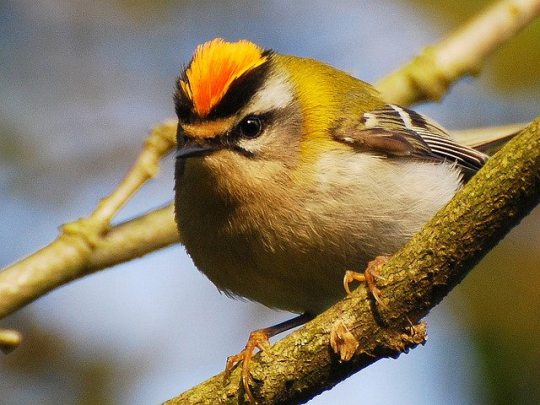
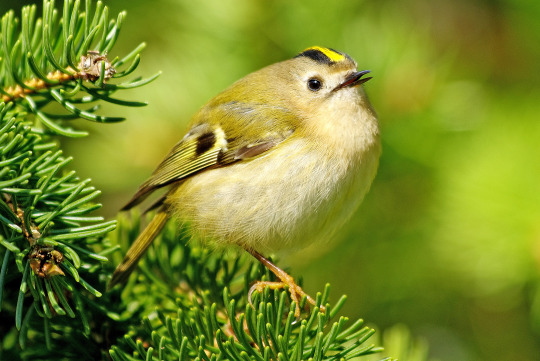

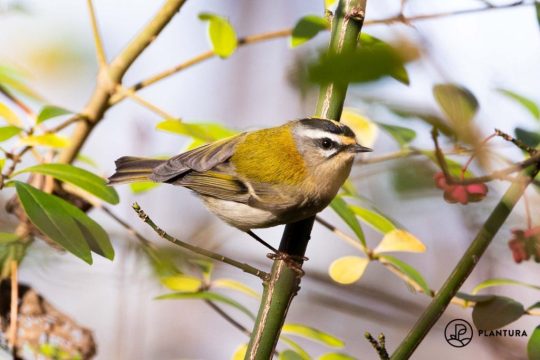
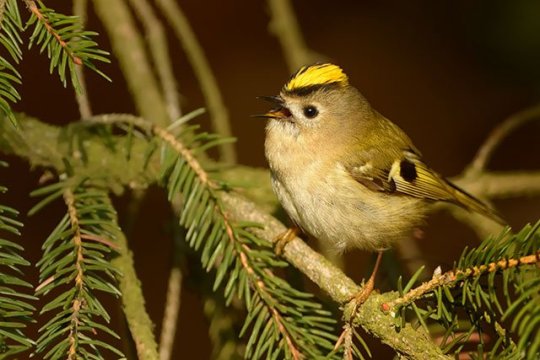
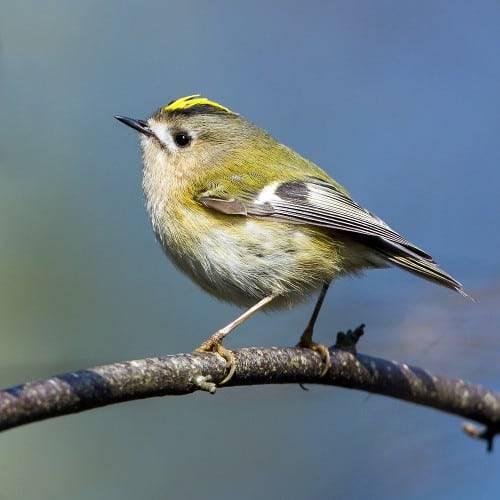
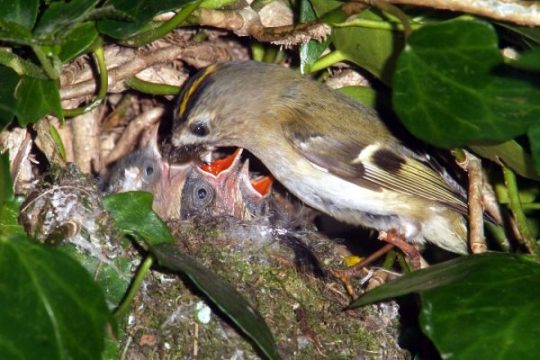
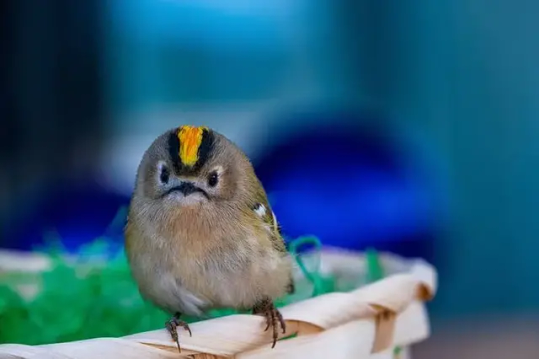
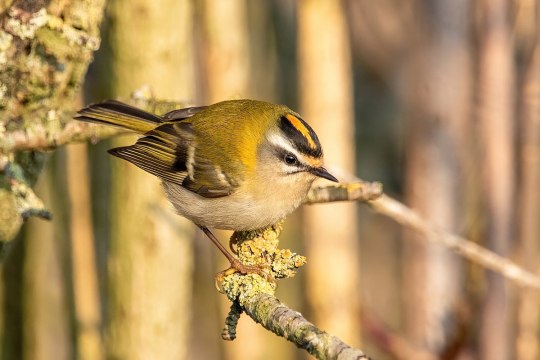
Regulus regulus better known as the common goldcrest or as the "king of the birds", very small passerine bird in the kinglet family which is endemic to much of Eurasia from the Iberian Pennisula to the Korean Pennisula and from as far north as Siberia to as far south as India, along with patches of North Africa and several islands including but not limited to Japan, Iceland, Sicily, Taiwan, Sardinia, Crete, Ireland, Corsica, Britain, and the Azores. These birds typically live alone or in monogamous pairs which tend to inhabit heathlands and coniferous forests up to 9,800ft in elevation. Here they feed primarily upon insects and other arthropods such as moths, crickets, amphids, spiders, caterpillars, springtails and flies, as well as tree sap. This species is partly migratory, with the northern most populations traveling north to breed and south to over winter. Reaching just 3.3 to 3.7 inches (8.5 to 9.5cms) in length, .16 to .25oz (4.5 to 7 grams) in weight, with a 5.3 to 6.1 inch (13.5 to 15.5cm) wingspan, the common goldcrest is Europe's smallest bird. It is similar in appearance to a warbler, with olive-green upper-parts, buff-white underparts, two white wing bars, and a plain face with conspicuous black irises. The crown of the head has black sides and a narrow black front, and a bright crest, yellow with an orange centre in the male, and entirely yellow in the female. The small, thin bill is black, and the legs are dark flesh-brown.The breeding season begins in April or May depending on the region. A pair will build a well-insulated 3 layered cup-shaped nest out of moss, small twigs, cobwebs, feathers, hair, and lichen in the branches of a tree. Here the female will lay 6 to 13 eggs which are incubated 16 to 19 days until hatching. Which are cared for by both parents until they fledge some 17 to 22 days later. It is not uncommon for common goldcrest pairs to lay 2 or more clutches in a season. Under ideal conditions a common goldcrest will reach sexual maturity at around 1 year of age and may live upwards of 7 years.
2 notes
·
View notes
Photo



Trentepohlia umbrina, high up in the Mt. airy valley black walnut, Cincinnati, Ohio.
I see three pretty common lichens on this tree but I was not actually trying to photograph any of these despite getting some good shots of one Lecanora hybocarpa complex lichen. aka bumpy rim lichen. Which I actually wanted to use as scale for the size of what I really wanted to take pics of.
Instead I was trying to photograph this beautiful red streak because I feel like often it is over looked and under appreciated from a botanical and mycological perspective, often even assumed to be part of woody material on red oaks as cork or lenticil tissue.
There is a niche group of semi complex crack species and exposed surface species of filimentous algae, actinomycetes, and cyanobacteria that make up a good portion of tree bark biota that we don’t often get taught about despite many of them being directly associated as a functional group(photobiont) of many lichen species. In this case, subaerial algae is the noted or deamed group type, this one on Black Walnut bark high up in the canopy is a filimentous chlorophyte...
https://www.researchgate.net/figure/Examples-of-subaerial-habitats-and-algae-on-and-in-plants-A-Thin-film-of-green-algae_fig15_280577788
specifically the carotenoid rich Trentepohlia spp., Most species of Trentepohlia species are generalistic, even pollip clustering or forming long elongated hairs that are free standing and grow on rocks and trees freely depending on moisture and mineral contents. Some are directly associated with parasitism or within’ lichen as a mutualist coevolved as photobiont.
Most species are pretty dang hard to Identify, resulting in utilizing microscopy or sequencing in order to resolve a taxa delineation.
Here, pictured above, is a very small species of bark dwelling caespitose (mat forming) relatively as prostrate as possible( growing non erect and almost adhering to the surface.) The good ol’ fashion algae is easy to get a sample of and put under a scope free floating in water, once done look at the filimentous grouping, linear psuedoseptae with elongated cells in conjunction with the roles of plasmodesmata for cytoplasmic streaming is not what I saw, instead I got adjacent rounded blobs forming the filamentous line with most of the pigment filing the cells. So matted dark red tree balls is what I viewed, Trentepohilia umbrina. The interesting thing is that this species is very small and while preferring exposure/barren niche like many Trentepohilia spp. do; we see this species in shaded cracks and crevices more than in zones of full exposure. Hence why umbrina may have been selected as epithet. ( within the shadows)
The most common species and easiest to ID are:
Trentepohlia abietina ( a small polip cluster forming tree only species) often associated with elongated cell structure. (https://www.jstor.org/stable/44841106)
Trentepohlia aurea Orange rock hair (the only species with an english common name that I am aware of) most of the other species only seem to have dutch, norwegian , russian, siberian, or native american first nation (inuit, metis, Musqueam, Squamish, and Tsleil-Waututh) names. This species is huge and easy to see the hairy polip clusters.
Trentepohlia jolithus , a true nordic and beringian species limited to high volcanic regions in the northern hemisphere and very bright and prostrate forming dense mats on rocks appearing as a film
Trentepohlia umbrina , or as I call it, matted on bark dark red tree balls clustered as a filamentous line, https://www.inaturalist.org/taxa/410587-Trentepohlia-umbrina/browse_photos This is what you see under obs scope, If you
Other common species but with no accessibility as far as ID delineation are these:
Trentepohlia flava , a coastal salt mist generalist species often found along the western coast of North America on rocks but also commonly found in europe near sea side areas in the north, while this doesn’t fully explain it’s locality niche or fix any range maps because we really don’t know if it has a cosmopolitain range or not and already a var. complex has formed along with range divisions.
https://www.proquest.com/openview/7f3a8e73a75fb8212470443aa189452c/1?pq-origsite=gscholar&cbl=37953.
The rest of these species in the genus are very inaccessible without ITIS or a lab to access.
#Trentepohlia umbrina#trentepohlia#botany#plantblr#mycology#lichenology#dendrology#physiology#algae#kawaii#lichen#lecanora#lecanora hybocarpa#umbrina#red stuff on my tree#ohio#juglans nigra#juglans
44 notes
·
View notes
Text







Bacidia fraxinea
This crustose lichen has a gray-green, continuous to rimose-areolate (cracked and tile-like) thallus that grows on the nutrient-rich of deciduous trees (particularly those of the Fraxinus variety). It has bulbous, salmon to orange-brown apothecia which produce long, needle like spores. You can find B. fraxinea in mild-temperate habitats in Europe, though records of it are sparse. More work is needed to fully separate records of this species that are likely confused with its more common look-alike, B. rubella.
images: source | source
info: source | source
#lichen#lichens#lichenology#lichenologist#mycology#ecology#biology#fungi#fungus#nature#symbiosis#symbiotic organisms#algae#Bacidia fraxinea#Bacidia#trypo#trypophobia#lichen a day#daily lichen post#i'm lichen it#lichen subscribe#natural science#environmental science#life science#see the forest for the lichens#go outside#take a hike#look for lichens#lichens are so good
51 notes
·
View notes
Note
Very silly request but I’m writing a story about Scottish wildcats (kind of a warriors ripoff but with more autism) and wanted to ask- what sort of landscape and nature details would make you immediately go “yup that’s Scotland”
itsnot silly, thats kinda fun :-o !
for wildcats, they live in the moorlands and woodland edges, mostly in the highlands where it's not really populated as much, but not high altitudes. they stay sheltered too, so not on the coasts.. so basically to answer your question: heathery moorlands with the dark black soil and big lichen-y outcroppings and boulders left from glaciers n things, patches of very mossy boggy rainforest with old short trees .. also woodland with birch and hawthorn and scots pine and blaeberries and lichen all over the forest floor. burns (its a stream) with tiny waterfalls and bracken and ferns on the sides, and vry clear but orange-red tinted water, from the peat and iron n stuff. little lochs too. and even with the cats staying in sheltered places, the bens in the distance or towering above them if they're in a glen :-3 thats all super super quintessential scotland landscape to me .. other details could be birds of prey flying around, like buzzards are vry common to hear.. the deer of course, pine martins and grouses and eagles and little newts and red squirrels. lots of wind and rain. everything is very wet pretty much all of th time, thats why i mention so much watery things, lochs and burns and moorland.. it is soggy :-3 lol
#(excluding ocean things because the wildcats arent at the sea)#ok thats all i think :-3#i do rly love th landscape here a lot#asks
49 notes
·
View notes
Text
People, Part I
The Djosé

The Djosé are a tall, fur covered humanoid with two horns. To us, they would look like a bison-person in the same way a minotaur is a bull-person and a fawn is a goat-person. Despite their size and relative strength they are generally peaceful and gentle people, unless provoked.
The Djosé of the Great Stone Desert and the Moody Mountains of the northern Dawnlands have no gods, they are ancestor worshipers. Due to their unique physiology, they don't breed and have children like we do, they die, and eventually the body regenerates and is born again with no memory of the previous life. They quite literally reincarnate as a means of reproduction. A quirk of this method is they have need of only one gender, or to be more precise, are genderless.
Djosians believe that you as a living individual only exist in the speck of time when your soul (or Djo) and your body (or Sé) are combined. When you die your body awaits regeneration and your soul moves on to a new body. Therefore, all individuals you ever know or come before you are truly unique. A death is therefore both tragic and wonderful, and the Djosians hold those who have died with great regard (hence Ancestor Worship).
The purpose for existence, they believe, is to experience every possible thing through the eyes of every possible person. They believe that one day the universe woke up and went mad from the sheer immensity of everything, so it split itself into shards (Djo) to better understand itself, and that one day, all souls will have lived in all bodies, and the souls shall combine into the Great Djo (essentially the first "god") and the bodies shall combine into the Great Sé (essentially a new world).
The Djosé have a very significant funeral right that each individual begins at reincarnation (birth). Each Djosian will build an intricate stone stack throughout their lives, into which they will incorporate items or carvings to represent pivotal times or experiences in said life. Upon death, a Djosian is tied in a funeral sack filled with a specially bred moth that dehydrates the body and organs, preserving them. The moths are then released, never to be reused, and the body is intermed in the stone stack to await its next life.
This process is timely and difficult, as the stacks are not in specific locations such as a cemetery, but a location of significance chosen by the Djosian who builds it. The stacks, once vacated, act as memorials and shrines at which the living meditate.
On very rare and momentous occasions two Djosians might meet who's souls and/or bodies once formed another individual, a common Ancestor. This Reunion is very special, as Djosians can't remember past lives, and this chance encounter allows both of them to commune with their common Ancestor. Such a meeting is marked out by their horns starting to glow as they get closer to each other. Such events occur once or twice in a generation, and are celebrated in a holy festival known as Séjoar in Djorian (their language).
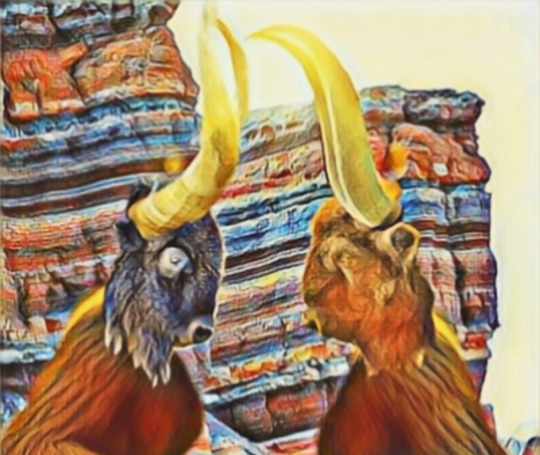
Both individuals meditate and receive three visions, a shared memory that they both see, and one separate vision each. By tradition they must never speak of these visions, except for the shared memory. This is followed by feasting and celebration.
The Djosé come from the harsh Stone Dessert, that according to legends was swept clear of all earth and vegetation by a thousand years of rain that wore the mountains flat. The Djosé are the only race hardy enough to call it home, and live off lichens and mosses, which is about the only things that grow there. The stone desert resembles a real world mesa dessert, but instead of warm reds and terracotta oranges, it is coloured grey blue slate, with bands of green and turquoise, laced with fine golden veins. The area's mineral resources are of great interest to outsiders, if they could only figure out a way of surviving it.
On the rare occasion a Djosian might venture beyond its homeland, it might discover it is known by another name; Troll.
#medievalcore#adventurecore#rangercore#goblincore#fantsay#fantasy rp#fantasy writing#fantasy race#fantasy world#fantasy#fantasy roleplay#lore#oc#oc lore#world building#oc world#tesblr#creative writing#writing project#writing
6 notes
·
View notes
Text
[Yes I am alive. As per usual, life has been taking up more of my attention than I really like, but hey I managed to write a thing that's been living in my head rent-free for months - more details at the end!]
youtube
Seda would be the first to say she wasn’t a superstitious person. But at the same time, she had picked up a number of subconscious personal beliefs and rituals through the years that belied that claim.
Fakhri’s mentor had been interred on the outer edge of the city, on a peaceful bluff near the river. It was a beautiful spot; large stones offered visitors a place to sit in the sunshine, and the rush of the water combined with the lush greenery provided a sense of privacy and connection with the land.
The visits began shortly after Fakhri first took her to the site. Perhaps it was a sense of duty; she had never met Akbar, but knew he had played a large part in Fakhri’s life after he left the mountains – and thus, she felt she should honor him as a parental figure. True, her upbringing had been unusual, even by miqo'te standards, but she understood the threads that connected generations together and how they played a part in a solid family unit.
Perhaps it was superstition, and her visits to the graveside were insurance that any lingering spirit was properly honored and placated. Or perhaps it was simply a desire for the familiar – she had regularly visited the shrine Bocquet had erected for her mother before leaving the Shroud, and her move to Thavnair had been a great deal of upheaval all at once; it would be reasonable for her to grasp at something that had soothed and comforted during the tumultuous transition to young adulthood.
She couldn’t explain her need, and while she never actively attempted to hide her visits from Fakhri, she never brought them up either. The subject was neatly avoided by slipping out in the wee hours after dawn while he slept, or during spare moments when he was otherwise occupied.
It began with an introduction, as all relationships do; there were forms to be followed, after all - just as when visiting the living. Gracious gratitude to the host was shown by brushing dust and lichen off the simple stone marker. Luckily, no weeds needed to be plucked; she had not yet learned to identify the ones that made one itch.
Respect to an elder was kneeling beside the graveside and producing her gifts; only having stories of Akbar to go on, she had to guess on what would be appropriate. A small cone of incense provided the resinous scent of evergreens - an homage to his student, as their common connection was Fakhri. Food and drink was common - on the first visit she provided a carefully peeled orange; the juicy wedges tucked into the skin to protect them from the ground. A a few drops of good whiskey from a flask were dribbled at the base of the stone. Later, she'd consume them herself, but the first samplings belonged to the dead.
And finally, something for the soul. She was never a musician – and trying to be something she wasn’t felt wrong; especially when the one she was honouring was a master musician himself – so she offered conversation instead.
The first chat, she told the stone who she was, and how she had a connection. It surprised her how easily she fell into the old habit of conversing with someone that wasn't actually there, and how comforting it was, to 'talk' to someone that was more... adulty... than she. (Introspection on how talking out loud to a venerable elder sometimes helped one navigate tricky emotional paths was not something she would consider until much, much later.)
“He’s special,” She confessed to the air in the early days of her relationship with her viera partner. “I don’t know what it is, but I feel… less, without him around.”
As time went on and she continued making regular visits, she began telling Akbar more about herself; in her imagination, she envisioned the two of them seated together for a drink – sometimes coffee, sometimes something stronger. She made a point of telling him all the latest about Fakhri, and any antics Arak had gotten up to since her previous trip.
As the moons passed, she began to notice small things. Tiny flowers sprung up beneath where she habitually placed the food offering. Sometimes she’d catch snatches of laughter or music when the wind changed – always when it would be appropriate to the ‘conversation’ as a response. It was purely coincidence; she knew that. But it helped cement the feeling of connection – and foolish as it may have been, she hoped the old man would have approved of her.
It was a crisp morning, midway through the Second Astral Moon when she made her way to her usual spot. That day’s offerings were a cup of steaming tea and some sort of baked pastry, placed carefully as she settled in, taking a moment to close her eyes and gather herself after her usual greeting.
“We haven’t told anyone yet, but… I’m pregnant. The baby should arrive in the Sixth Astral Moon - around Fakhri’s Nameday. Hikmat- the Sahib, that is- says it could be any time between the 10th and 25th—”
She broke off as the wind rushed around her, teasing at her hair and plucking at her clothing, knocking both tea and pastry over with the strength of its breeze. Music echoed over the Rise, indistinct voices lifted in song and cheers, drums and other instruments she couldn't pinpoint wove around them in a joyful tapestry of sound.
Seda sat stunned. Never before had any of the random, coincidental 'responses' been this fast, this fierce. Normally it was a sensation of the breeze playing with her hair, or a child's laughter.
Her vision blurred as emotion, ever close to the surface with the changes in hormone levels, overflowed in a rush of gratitude. It felt like Akbar - and the city itself – celebrated their news. Sure, there was a logical explanation – there always was. But in that moment she felt embraced, welcomed, and secure with her place in her partner’s world.
And that’s all that mattered.
@gray-morality
[Footnotes: Okay I said I'd have more at the end -- I've had this scene rattling around in my head since October. Obviously not the announcement part - but something sweet where she's trying to connect with Fakhri's past.
For the announcement, we've known since February, and let me tell you, that's been a challenging secret to keep! Seda and Fakhri have not yet told anyone (save Hikmat) ICly; I think Seda's afraid of what the grannies of the Meyhane would try and feed her -- They know, of course. The older generation always does.
I took a great deal of liberties with Akbar's spirit and internment, so any 'ghostly' interactions could very well be the result of fancy and wishful thinking - they should not be reliably thought of as anything save interesting coincidence. :) -- And I dug through old chat logs for his name, so that may be incorrect as well. :3 ]
7 notes
·
View notes